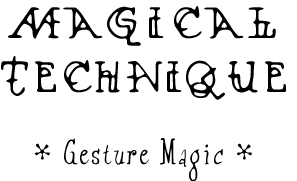 |
 Fantasies have produced magicians who could create change with a wink, a wave of the hand, or, or a twitch of the nose, and these same fantasies have inspired an exploration of the power of movement in Magic. Of course one can divine information about a person from their body language, and everyone knows how people get directions from hand gestures or nods or whatever. Most of these seem based on trained responses, i.e., you know what someone is trying to communicate because you've learned to connect motion X with a meaning or range of meanings. For example, a man looking for a rake in the yard might ask his wife, inside, where to find it by making rake motions and shrugging inquisitively. She might answer by touching her eye, breast, rump, and crotch, signalling "eye, left tit, behind, the bush." Such signs, however complex, represent ordinary modes of communication. Aside from hypnosis and stage magic misdirection, it seems possible to make magic work through gestures as well as through words or symbolic pictures. These could be constructed as kinesthetic 'sigils" based on body postures (mudras), hand movements (bandhas), or complex movements like Tai Chi. Mudras tend to create general states of consciousness, while bandhas allow for specific paychic maneuvers within those states. For example, one might use the Sign of Shu (also known as the Elemental Sign of Air, the Sign of the Theoricus Grade, and the Masonic Hailing Sign) in an invocation of the attributes of Air: adaptability and resillience. The sign, formed by holding the arms outward with the forearms turned upwards, allows the lungs to inhale greater quanities of air to provide a physiological basis for magical changes in consciousness. Bandhas can take the form of signs traced in the air (such as those appearing in the numerous Pentagram Ritual variants) or simple hand signs, such as the benediction sign used by Roman Catholics. Construction of the somatic sigil follows a similar process as does the creation of a verbal or visual one, except that the magician traces the sign or forms the hand into the proper letters or signs. Repetition seems the most reliable method of getting the subconscious to recognize these movements as more than trivial motions, but the effects of the gesture do not limit themselves to the mind of the magician.
Since this writing, i've come to realize that the key to working with the bandhas is to perfect the discreet use of mudras. A mudra designed to represent a tiger about to pounce, for example, makes a martial bandha useful immediately, rather than pre-implanting it with tiresome repetition. Whether the sigil acts upon the mind of the magican only, or upon the Aethyr itself, it is obvious to me that without a means of accessing the "occult" portion of the mind in casting the sigil, it does nothing unusual. My start with somatic sorcery (and as far as i know, i am its pioneer) was to use it for simple divination and mnemonic recall, like finding lost items and police cars hidden on the highway. I've since developed and employed a host of signs for various purposes. The most useful ones i've found for everyday use involves stimulation of the outer ear as an aid to clairaudient sensing of other's thoughts, and another which summons a defensive egregore for dealing with unsavory persons and bad neighborhoods. Twice i've used them for attack: once to outright injure a person, another time to humiliate. I'd love to see the result of teaching Magic to "gangstas" and empowering a sort of underground army. They already use signs, words, and glyphs in their "rituals" and it would be fun to see what they do if they found the power behind these.


|
 |
 |


